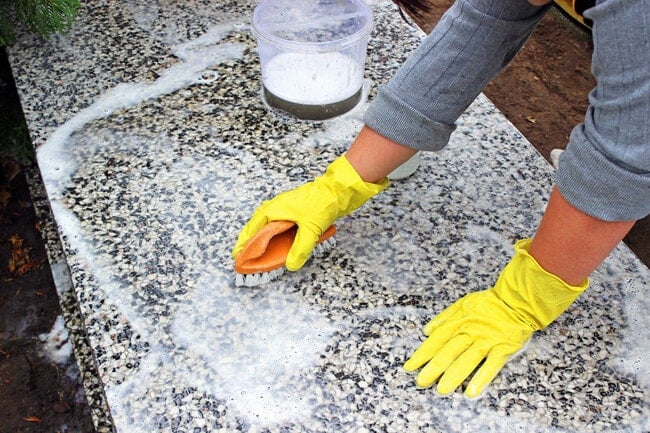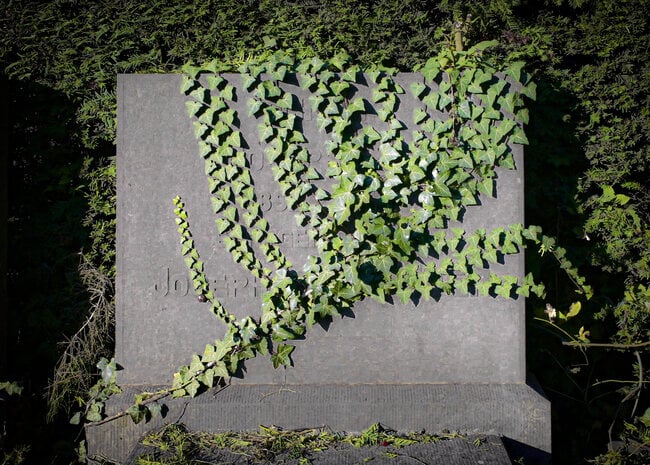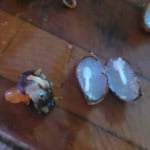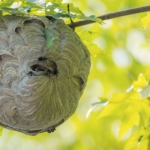How To Clean A Gravestone

Wondering how to clean a gravestone properly without causing damage? Protect your loved one’s lasting memorial with our simple guide.
Over time, a headstone’s surface can unfortunately fall victim to the elements and accumulates environmental buildup — dirt, lichen, moss, algae, bird droppings, tree sap, soil splashing, mildew, and pollution. Regularly maintaining and cleaning a love one’s headstone makes it a beautiful place to visit. Whether you wish to beautify a resting place, or if you read cemeteries for historical documentation, be sure to tackle this project with a bit of know-how and proceed with harmless methods to prevent further damage. Here are some helpful suggestions.
Before Cleaning
Before cleaning a gravestone be sure that the monument is structurally sound and is not in danger of falling. Lightly tap on the stone. If you hear a hollow sound, the stone could be delaminating (the layers of the stone may be separating). If you notice any cracks, loose sections, or severe damage, do not attempt to clean. (This is a job for a professional stone conservator or preservationist.)
Next, remove any unwanted plant growth. Gently pull off any plant life without causing damage to your headstone. Plants such as ivy may need to be cut at the base and every 6 inches. (We do not advise tugging on the vines as this may cause harm to the gravestone.) For thicker growth, allow it to die after it is cut back before removing and proceeding with cleaning. Regularly weed and maintain your gravesite to prevent future overgrowth.

Less Is More
Cleaning helps to preserve the stone and is not intended to make the marker look like new. Improperly or unnecessarily cleaning a grave can accelerate its deterioration. Always choose the least invasive method and materials. Some basic cleaning supplies and a little elbow grease are often all you need to safely make a drastic difference to a gravestone. Before attempting to freshen up a loved one’s resting place, consider these steps and methods.
Note: Gravestone cleaning is best done in moderate temperatures. We do not advise cleaning gravestones before your area’s last frost dates. (Average Frost Dates here.) Adding water to a gravestone before a frost will cause water to expand and may cause cracks. Alternatively, if it’s hot outside, please allow your water to warm in the sun before using. Cool water on the hot stone may cause cracking.

Supplies
Water is your best friend when cleaning a gravestone. You will need many gallons of water to get the job done, so come prepared. Most cemeteries have a water supply. (If not, old plastic milk jugs work great for transporting water.) A 1–2-gallon garden pump and spray bottle also works well, but do not use a power washer.
- Brushes: Choose a soft bristled brush (natural or nylon) to scrub. Never use a metal or wire brush. You may also want to bring a broom with you to sweep away any loose dirt or debris.
- Scrapers: Bring a plastic or wooden scraper for eliminating debris from large areas on the stone.
- Wooden skewers, craft sticks, and cotton swabs are great for getting into tight spaces. Toothbrushes are also handy tools to safely clean carved areas!
- Old rags and towels.
- Safety gear: Glasses, gloves, and kneepads.
- For stubborn stains you may need a gentle cleaning solution. (See our suggestions below.)
Cleaning Solutions And Usage
Many cleaning solutions can gradually deteriorate the stone. Avoid corrosive cleaners such as bleach (or products containing bleach), and acidic solutions, such as vinegar and lemon juice. There are a number of safe biological stone cleaners on the market or consider making your own safe and effective DIY headstone cleaner. Here are some examples.
- Basic Cleaner: Regular dish soap and water work great as a basic cleaner. First, remove as much excess gunk as possible with a dish scraper, getting inside the engraved lettering. Mix a large bucket of warm water and dish soap. Use a soft bristle brush and scrub the gravestone in circular motions. Dip cotton swabs in the solution to clean inside engravings, if needed.
- Baking Soda: A baking soda poultice is often effective at removing discolorations and lifting blemishes from porous stones. Add 1 cup of baking soda with 5 Tablespoons of dish soap. Slowly pour enough hydrogen peroxide into the bowl to create a thick paste. Spread the paste over stained areas and let it sit for several hours before washing away and drying. Stubborn stains may need some scrubbing with a brush using circular motion.
- Ammonia Cleaner: An ammonia-based spray cleaner is a safe solution for removing and preventing fungi growth, such as lichens. This mixture also works on hard water strains and other discolorations. Mix 4 parts of water with 1 part ammonia in a spray bottle. Shake well and spray solution over the gravestone.
After cleaning, be sure to always rinse away any cleaning solution with clean water, leaving no residue behind. Dry thoroughly with a clean towel to prevent any streaking.
Do Not Use Cleaning Solutions Often
Do not clean with solutions too often. Cleaning solutions and the agitation from scrubbing can deteriorate the stone over time. With each cleaning, tiny particles are removed from the stone, so frequent, over-cleaning, or improper cleaning practices can be harmful.
Stones made from slate, sandstone, or marble, deteriorate more quickly, and should only be cleaned once every 7 to 10 years. Bronze markers can be cleaned every 3 months. However bronze will develop a blue-green patina over time and cleaning will not remove this despite your efforts.
Note: If you wish to clean a headstone that does not belong to your family, first get permission from a descendant, the sexton, cemetery superintendent, or the town.
Join The Discussion
What is your method for cleaning a gravestone?
What flowers do you place near your loved one’s headstone?
Share with your community here in the comments below!
Related Articles
Seeing Dimes? Signs From A Loved One

Peter Geiger
Peter Geiger is the Editor of the Farmers' Almanac. Read his full biography.






What dish soap is recommended for cleaning a tombstone as I have read that dawn is not to be used.
Is it best to seal a marble marker after it is cleaned?
just moved into a new house that has a huge graveyard (20ish graves) from the 1800’s. wanted to bring them life since they are all broken or covered in vines since they have been forgotten
What a wonderful way to honor that space and those that are buried there. We hope the articled helps.
Cleaned a grave and it left a chalk residue on the marble how do you get it off please thanks
Richie
WE SPRAY WITH WET & FORGET AND THEN LET THE ELEMENTS “WASH IT DOWN”
Do you have any tips for the flat brass markers how to care for them ? i heard someone say they even applied a coat of TurtleWax to them !
I have a question. The lettering on my fathers headstone is completely faded. Is there a certain type of paint I could use to repaint the lettering.
We recommend contacting the manufacturer of the headstone to see what they recommend for the particular stone and finish.